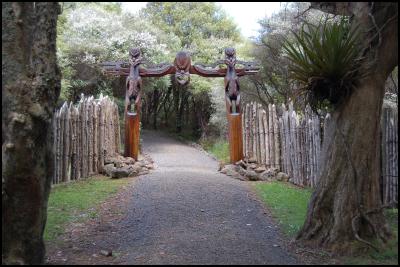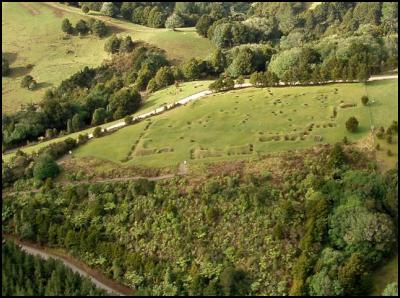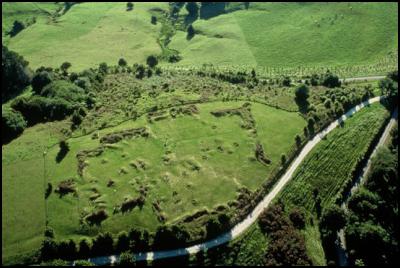Early Maori Military Engineering to be Honoured
Early Maori Military Engineering Skills to be Honoured by New Zealand Professional Engineers

Click to enlarge

Click to enlarge

Click to enlarge
14 February 2008
Early Maori Military Engineering Skills to be Honoured by New Zealand Professional Engineers.
In a first for a Maori
feat of engineering, the Institution of Professional
Engineers of New Zealand (IPENZ) has recognised Ruapekapeka
Pa as a national site of engineering significance. At a dawn
ceremony on February 16, representatives of the National
Engineering Heritage Chapter of IPENZ, the Ruapekapeka Pa
Management Trust, and the Department of Conservation will
gather to unveil a special plaque honouring the engineering
skills of the Maori warriors who built the Pa more than 160
years ago.
The gun fighter Pa, located 30 minutes north of Whangarei is comprised of a unique arrangement of rifle trenches, bunkers, tunnels and double stockade representing an ingenious indigenous response to European firepower. It was engineered and constructed by Warrior Chief Te Ruki Kawiti and his allies in late 1845 and was the site of the last battle of "Northern Campaign" of the New Zealand wars. It withstood a two-week artillery barrage before being captured by British and allied Maori forces on January 11, 1846. The Pa and battlefield are the best preserved remnant of the northern campaign and the nine hectare reserve includes the forward British position and main British camp.
With the installation of the plaque beside the modern carved entrance way, the site stands alongside important New Zealand engineering icons like the Auckland Harbour Bridge and motorway, and the Hamilton jet unit.
IPENZ Heritage Spokesperson Trevor Butler says that the recognition and honouring of Maori engineering skills at Ruapekapeka is a significant occasion for the NZ Institution of Professional Engineers who hope that this will be the first of other historic Maori innovations which can be honoured in a similar way. "Ruapekapeka may not have been the first pa to utilize trenches or to have strong palisades, but the combination of design innovations made it one of the most effective against assault by muskets and heavy artillery". While modern engineering has become the routine application of detailed codes, standards and computer models, and applying international practices to local problems, “Real engineering is the pondering of a problem not encountered before, considering options and developing an effective local specific solution. It requires the merging of innovation, technical and interpersonal skills. Ruapekapeka demonstrates this and represents good, sound engineering problem solving”.
The fortifications so impressed the British that following the battle, military engineers from Britain twice surveyed the defences, built a scale model for education purposes, and tabled the plans in the House of Commons. Some historians have argued that the knowledge was used by the British in the Crimea in 1853 and led to the trench warfare of World War 1 when machine guns made underground warfare a necessity.
DOC Whangarei Area Manager John Gardiner, who has a 25 year professional association with the Pa, noted that shortly after the battle, Governor George Grey compared the developing military capabilities of the Maori combatants to those of Europe's finest 19th century generals, "so it’s fantastic that Ruapekapeka continues to receive recognition from such diverse communities of interest". Ruapekapeka Trust Chairwoman Ripeka Taipari is also pleased with the acknowledgement but says that there is more work to do to share the story of Ruapekapeka. "Many hands played a part in the construction of the Pa and its impossible to recognise them all on one small sign. The Trust and DOC are currently looking at ways to preserve and promote as many stories as we can, using new technologies like the web and cellphones to get the attention of our youth."
This work is part of a National Historic Heritage Restoration Project funded by DOC. In December 2003 the first stage of the restoration was celebrated when tangata whenua led a dawn dedication ceremony attended by the Minister of Conservation, the Hon Chris Carter.
In recent years, DOC and the Ruapekapeka pa Management Trust have established a car-park and loop track that passes through the British camp, down through the remnant puriri bush and up to the Ruapekapeka Pa site entrance. Here, a carved gateway or waharoa created by master carver Te Warihi Heteraka has been erected. New interpretational signage has been installed and DOC has recently commissioned detailed mapping and geophysical survey of the battlefield to identify sub-surface features. The Ruapekapeka Pa Management Trust has embarked on an ambitious Oral History Project to collect stories and traditions from the descendants of Maori participants, which will form an important part of the growing body of information about the site.
Key
Points
- Ruapekapeka Pa is being recognised as a national
site of engineering significance by the Institution of
Professional Engineers of New Zealand on February 16, with a
dawn ceremony to unveil a commemorative plaque.
- This is
the first piece of Maori engineering to be so recognised, on
account of Ruapekapeka’s unique arrangement of
gun-fighting trenches, artillery bunkers and stockade.
-
The Pa was built during the "Northern Campaign" of the New
Zealand Wars of 1845-46, which began with Hone Heke’s
sacking of Kororareka (Russell) on 10 March 1845 and
finished with the capture of the Pa after a two-week
bombardment on 11 January 1846.
- The Ruapekapeka Pa and
battlefield is managed by the Department of Conservation in
partnership with the Ruapekapeka Pa Management Trust
representing Tangata Whenua, with Trustees nominated by
Ngati Hine, Ngati Hau, Ngati Manu, Te Kapotai and Ngapuhi
Nui Tonu.
Further Information
Ruapekapeka Pa Historic
Reserve
http://www.doc.govt.nz/templates/page.aspx?id=44959
Ruapekapeka
Pa Management Trust
http://www.doc.govt.nz/templates/page.aspx?id=44964
IPENZ
and engineering heritage
http://www.ipenz.org.nz/heritage/
Background
Built
by Warrior Chief Te Ruki Kawiti in late 1845, Ruapekapeka Pa
consisted of a network of rifle trenches, bunkers, tunnels
and a double stockade. It was purpose built by Kawiti to
counter European warfare techniques of the time. It
provided views over the whole of the contested landscape of
the northern campaign. In contrast to traditional pa,
Ruapekapeka did not guard borders, command important routes
of communication, or protect civilisations. Ruapekapeka Pa
could be abandoned without qualm. The aim was to draw
British troops to into battle on a difficult site.
No major buildings were erected. Instead, underground rooms were built that were designed to withstand heavy bombardment. Kawiti and his men sheltered together in dark bunkers like a colony of bats, an arrangement which gave the pa its name, Ruapekapeka, “the bats nest”.
After two weeks of bombardment, the British troops breached the palisades and on Sunday 11th January 1846, they entered the pa. They discovered, as with other Northern War battles, the pa had been abandoned before the troops entered. In the battle, the British suffered a total of 45 casualties, while the Maori killed and wounded numbered about 30.
At the end of January 1846, Kawiti and Heke negotiated a peace with Governor Grey. Ruapekapeka Pa was never re-occupied and was left to deteriorate following the battle.
Ruapekapeka was a large pa, measuring 150m x 70m, surrounded by two rows of 3m to 5m high palisades. These palisades consisted of puriri tree trunks and split timber lashed together and reinforced with bundles of protective flax padding. Between the two layers was a two metre wide trench divided into numerous gun fighter pits. When attacked, the defenders could fire through the outer palisade at ground level while remaining well protected from return fire by the fence and earthen walls of the pits. A second line of defenders could fire from the embankment over the heads of those in the outer trench.
A network of underground connecting tunnels, and bomb-proof shelters, strengthened by strong puriri bearers were built within the pa. The shelters were protected by earthen roofs and robust wooden huts. During times of bombardment they provided excellent protection of the pa’s inhabitants in the same way that bomb shelters were later used in WWI. Scattered within and behind the pa were felled tree trunks and raised mounds to provide cover should the palisades be breached and to hinder the attackers in the event of a direct assault.
This type of pa was far better equipped to handle cannon fire than traditional pa, but almost as important as its innovative construction was the location. A pa built inland, a long way from European supply sources and navy ships was in a strong position. The attackers had to travel through rough, unfamiliar territory, dragging all their equipment with them and would have little choice when it came to finding a suitable base camp.
Following the battle, the site was not re-occupied and was left to deteriorate. As a result, the timber palisades have completely decayed and disappeared. The system of tunnels and shelters have also deteriorated over time, however there is clear evidence of the trenches and mounds that formed the pa. A well on the site remains intact.
The site is of national cultural and historical significance because of its role in the mid-19th century dealings between the Crown and Maori. Ruapekapeka has been identified as a key historic site on the DOC estate in Northland and the site includes interpretation signage at both the pa site and the site of the British positions .
ENDS


 Maia Studio: Frankie Venter Performs With Coldplay At Sold Out Eden Park Show
Maia Studio: Frankie Venter Performs With Coldplay At Sold Out Eden Park Show Royal NZ Ballet: RNZB's Tutus On Tour Returns For Summer 2025
Royal NZ Ballet: RNZB's Tutus On Tour Returns For Summer 2025 Little Miracles Trust: The Little Miracles Trust World Prematurity Day Campaign
Little Miracles Trust: The Little Miracles Trust World Prematurity Day Campaign NZ Society for the Study of Diabetes: Critical Workforce Shortages Leave People With Type 1 Diabetes Unable To Access Life Changing Technology
NZ Society for the Study of Diabetes: Critical Workforce Shortages Leave People With Type 1 Diabetes Unable To Access Life Changing Technology Kindergartens Aotearoa: Kindergartens Aotearoa Opposes Lower Standards For Homebased Services
Kindergartens Aotearoa: Kindergartens Aotearoa Opposes Lower Standards For Homebased Services Universities New Zealand - Te Pokai Tara: Three Outstanding Aotearoa New Zealand Students Awarded Rhodes Scholarships
Universities New Zealand - Te Pokai Tara: Three Outstanding Aotearoa New Zealand Students Awarded Rhodes Scholarships